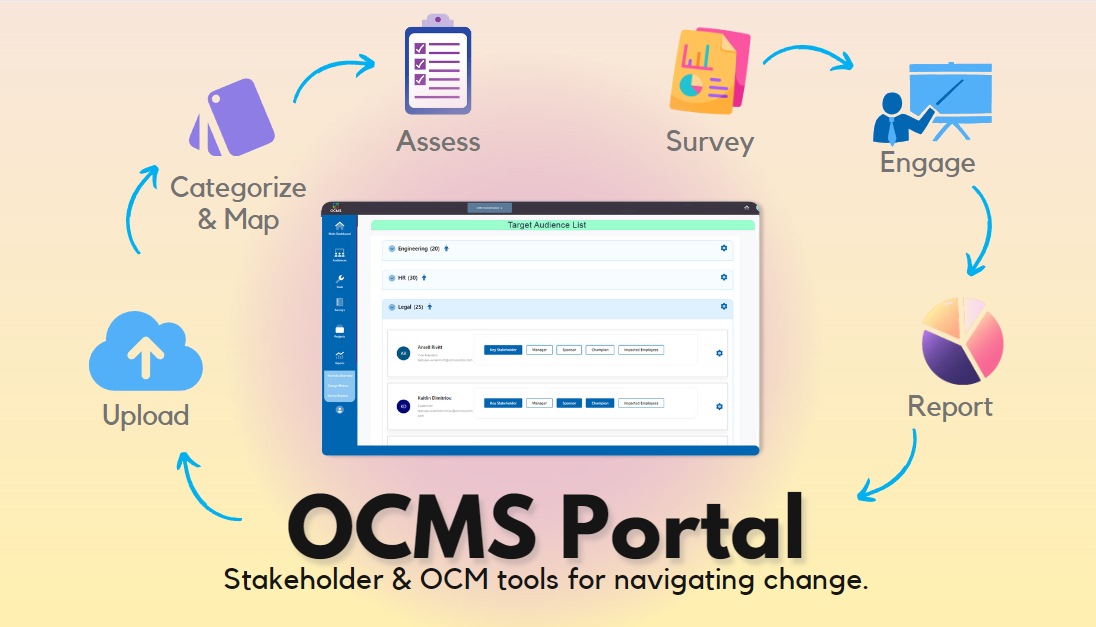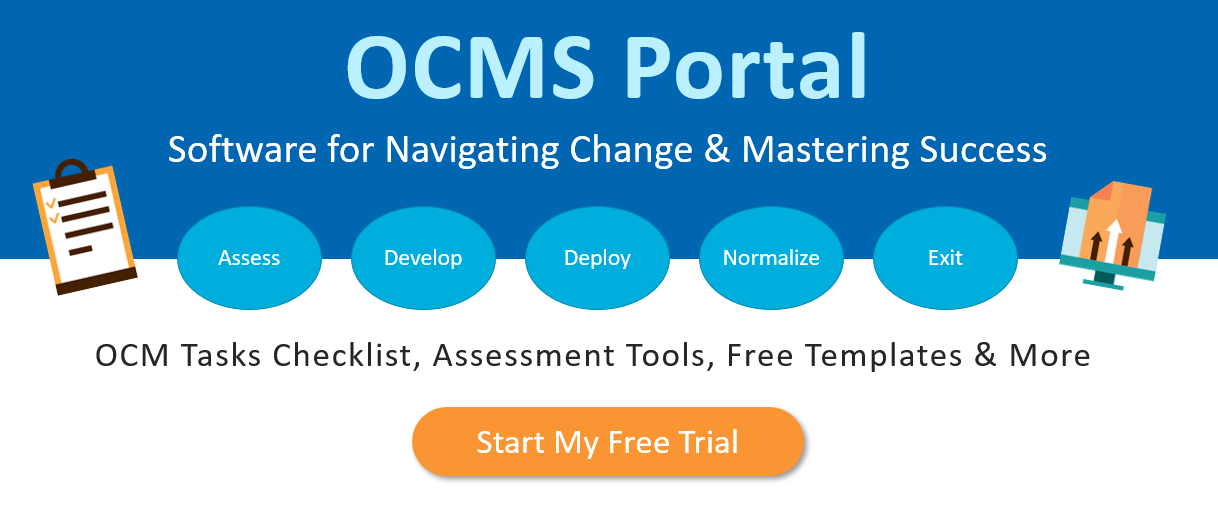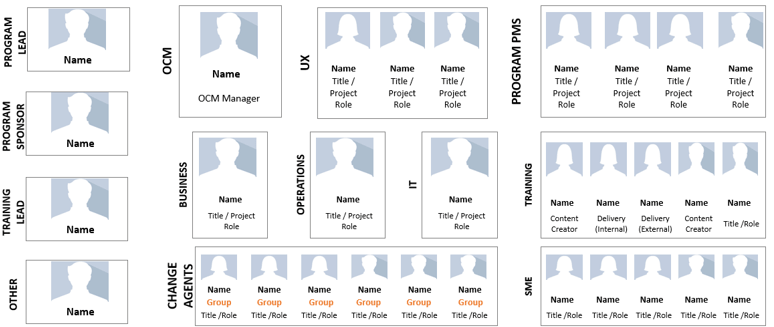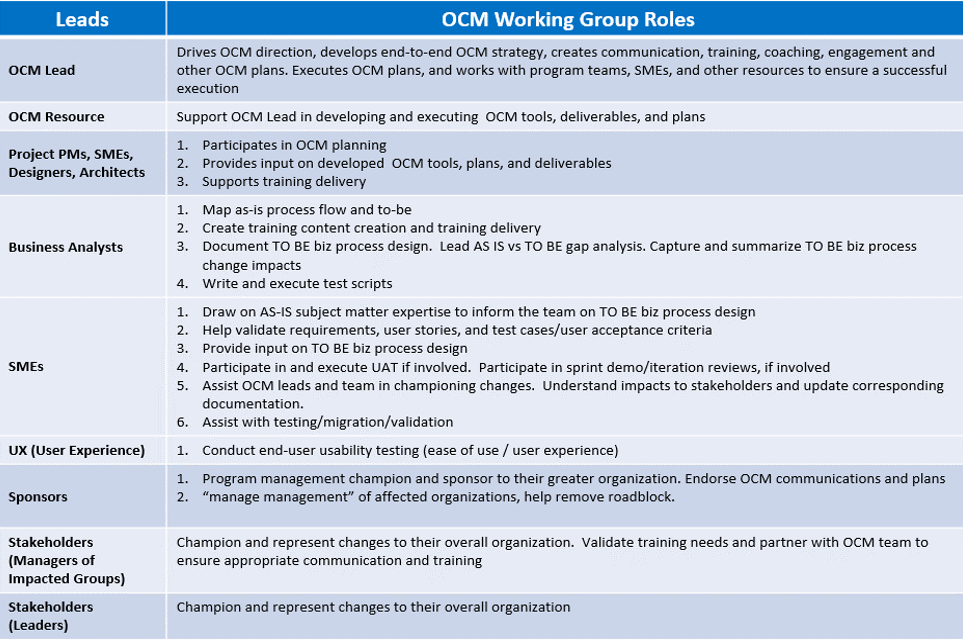Change Management Working Group Roles & Responsibilities
Guide for Launching & Managing an Effective Change Management Working Group
 Change is the only constant in today’s dynamic business environment. As organizations strive to stay competitive and adapt to evolving market conditions, effective change management becomes paramount. Change management aims to minimize the negative impacts of change and maximize the positive outcomes for the organization and its stakeholders.
Change is the only constant in today’s dynamic business environment. As organizations strive to stay competitive and adapt to evolving market conditions, effective change management becomes paramount. Change management aims to minimize the negative impacts of change and maximize the positive outcomes for the organization and its stakeholders.
One of the key factors for successful change management is having a dedicated change management group that can oversee and coordinate the change initiatives.
Establishing a Change Management Working Group is a proactive approach to navigating the complexities of organizational transformation. In this article, we will delve into the key steps and considerations for setting up a change working group and outlining the OCM roles and responsibilities crucial for its success.
What is a Change Management Working Group?
Although not mandatory, it is important for you to establish an Organizational Change Management (OCM) Working Group and establish change management team roles and responsibilities. For example, the change manager role or change agent OCM role.
There are typically two sets of organizational change networks are essential for a transformational change, program, large project, or initiative to achieve a higher level of success. One of these networks is a well-structured Change Champion Network. The other, equally important network, is your change management working group.
A change management working group is a team of people who have the authority, responsibility and skills to lead and support the change efforts. The change management group can consist of internal or external members, depending on the scope and nature of the change.
A change management working group includes members of the change management team, members of the program management transformation team (Business Project Managers, Program Managers, IT Project Managers, Architects, UX, and Subject Matter Experts, etc.) and other resources that can support the implementation of change management deliverables. Each have their own working group roles and responsibilities.
A cross-functional change management group is especially important when it comes time to engage impacted end users, as well as your targeted audience.
This group also provides tremendous value in designing, developing and implementing end-user training, UAT, Go-Live, and post Go-Live change activities.
For example, Program PMs, BAs and other resources who are subject matter experts might be needed when you make a change management group to present content during stakeholder and end-user meetings, roadshows, forums, town halls, and other large-scale engagement with impacted groups.
Do you have any questions about change management roles and responsibilities and how they differ from change champion roles and responsibilities? Please reach out and let us know.
Change Management Working Group Roles & Responsibilities
Your change management strategy, which will be developed based on the scale and scope of the change, as well as on the number of groups impacted by the change, will determine how many resources you should solicit to be part of your change management working group.
The more organizational groups that are impacted by a change, and the more change management activities need to be performed, the larger your change management group should be. This evaluation should be part of the Change Manager roles and responsibilities.
In general, the OCM roles and responsibilities of the change management group will include:
- Participating in change management planning and execution, including:
- Awareness email communication designing, development and communication broadcasts
- Presentations to impacted organizations and groups across the company
- Roadshows (In person or virtual) to educate impacted groups on the impacts
- Training
- Go-live preparations
- Post go-live change reinforcement
- Provide input on developed change management tools, templates, databases, and other samples
- Review and provide feedback on change management plans and deliverables
- Help conduct change impact assessments
- Manage and conduct as-is product data process flow mapping
- Perform business process impact assessments (as-is vs to-be)
- Support the OCM Lead/resources in remediating resistance
- Help in connecting OCM Lead/resources with key resources, leaders, and managers
Illustration: OCM Working Group Chart
Sample OCM Working Group Roles and Responsibilities
As shown above, there are many values and benefits that you can get from the change management working group that you launch. However, you want to ensure that you continue to engage this group, as well as continue to emphasize the benefits to them for being members of the group.
Such benefits to them include the ability to influence change management deliverables, as well as helping in the overall success of the program, for which they have a stake in.
Steps to Set Up a Change Management Working Group
1. Define the purpose and scope of the change.
Before forming a change management group, you need to have a clear understanding of why you need to change, what you want to achieve, and how you will measure success.
2. Identify the stakeholders and their needs.
Stakeholders are anyone who has an interest or influence in the change, such as employees, customers, suppliers, partners, regulators or shareholders. You need to identify who they are, what their expectations and concerns are, and how they will be impacted by the change.
3. Select the members of the working group.
The change management group should include representatives from different stakeholder groups, as well as experts in change management, project management, communication, training or other relevant fields. The size of the working group may vary depending on the complexity and scale of the change. A good rule of thumb is to have between five and 15 members.
4. Assign change working group roles and responsibilities.
Each member of the working group should have a clear OCM role and responsibility in the change process. Some of the common change management roles and responsibilities are:
- Sponsor: The sponsor is the senior leader who often initiates and champions the change. The sponsor provides strategic direction, resources and support for the working group. The sponsor also helps communicate the vision and benefits of the change to the organization and stakeholders.
- Leader: The leader is the person who leads and coordinates the working group. This is often included in the change manager roles and responsibilities. The leader is responsible for planning, executing and monitoring the change activities, as well as managing risks and issues.
- Analyst: The analyst is the person who conducts research and analysis on the current state, desired state and gap analysis of the change.
- Communicator: The communicator is the person who develops and delivers effective messages about the change to various audiences. The communicator also gathers feedback and evaluates the impact of communication on stakeholder engagement and behavior.
- Trainer: The trainer is the person who designs and delivers training programs to prepare employees for the change. The trainer also assesses training needs, evaluates training effectiveness and provides coaching and support for employees.
- Change agent: The change agent is anyone who actively supports and promotes the change within their area of influence. Change agents can be managers, supervisors or frontline employees who act as role models, advocates or influencers for the change.
5. Establish ground rules and expectations.
The change management working group should agree on some ground rules and expectations for how they will work together, such as:
- Meeting frequency, duration and agenda
- Communication methods, tools and frequency
- Decision-making process and criteria
- Conflict resolution process
- Working group roles and responsibilities
- Performance indicators
- Reporting requirements
- Risk management plan
- Escalation process
Do you have any feedback or questions about change champion roles and responsibilities, how to make a change management group, or OCM roles and responsibilities? Please reach out and let us know.
Need Streamlined Change Management Tools for Your Change Management Group?

From project risk, change impacts, and stakeholder assessments to adoption readiness, training and communications, the OCMS Portal has everything you need to coordinate and collaborate on your OCM project.
Conclusion: Guide to Change Management Working Group Roles & Responsibilities
Establishing a Change Management Working Group is a strategic investment in the success of organizational change initiatives. By carefully selecting dedicated individuals, defining clear roles, and implementing a comprehensive strategy, organizations can navigate change with agility and resilience.
As the business landscape continues to evolve, the ability to manage change effectively becomes a core competency for sustained success. Embracing a structured and collaborative approach through a change management group lays the groundwork for a positive and transformative journey into the future.
FAQ: Change Management Team Roles and Responsibilities
What is a change management working group?
A change management working group is a team of people who have the authority, responsibility and skills to lead and support the change efforts. The change management group can consist of internal or external members, depending on the scope and nature of the change.
Why is a change management group important?
Setting up a change management working group is a critical step for ensuring successful change management in an organization. A change management working group can provide leadership, guidance, support and coordination for the change initiatives.
What are some best practices when you make a change management group?
Some of the best practices for setting up a change management working group are:
- Choose members who have the right skills, knowledge, experience and attitude for the change project.
- Ensure that the members have a shared vision, goals and commitment for the change.
- Encourage diversity and inclusion in the working group to foster different perspectives and ideas.
- Build trust and rapport among the members by creating a positive and supportive work environment.
- Empower the members to take ownership and accountability for their roles and responsibilities.
- Provide regular feedback and recognition to the members for their contributions and achievements.
- Celebrate milestones and successes as a team.
Note: Content on OCM Solution's ocmsolution.com website is protected by copyright. Should you have any questions or comments regarding this OCM Solutions page, please reach out to Ogbe Airiodion (Change Management Lead) or the OCM Solutions Team today. OCM Solution was previously known as Airiodion Global Services (AGS).
External source: stock.adobe.com







